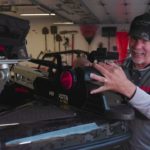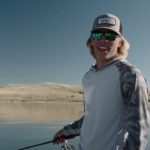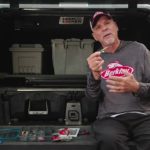Understanding Suspended Walleyes
Considering he was among the first (if not THE first) to target suspended walleyes on the Great Lakes and inland waters, Gary Parsons is The Man to best explain this often misunderstood fishing pattern.
Routinely fishing for suspended walleyes, whether it’s on the Great Lakes, western reservoirs, or larger inland lakes, it quickly becomes apparent they all have two things in common – big walleyes … and really big walleyes! It’s a fact … walleyes in these types of waters will suspend in open water, at least a portion of the season. Understanding when, why, and how they behave in these situations will positively help you catch more trophy fish season after season.
 The first step is to pinpoint the walleyes’ location … after all, you’ve got to fish where the fish are if you’re gonna catch ‘em. Cruise the open water basin using your electronics. Look for either big fish “arcs” or “clouds” of bait fish. Walleyes suspend primarily because of the availability of food, in the form of roaming schools of bait fish. Keep in mind that cold fronts can drive these fish to the bottom, and make them very difficult to spot. Marking suspended fish is no problem for most sonar units, but detecting the subtle “bumps” of bottom huggers is a whole different ball game. This is where you need some serious electronics. Top-of-the-line locators like the Lowrance LCX-19C, offer the ultimate in screen resolution. That’s what it takes to spot bottom hugging fish. Once you’ve located an area that appears to be holding fish, determining the right depth to run your baits is the next step.
The first step is to pinpoint the walleyes’ location … after all, you’ve got to fish where the fish are if you’re gonna catch ‘em. Cruise the open water basin using your electronics. Look for either big fish “arcs” or “clouds” of bait fish. Walleyes suspend primarily because of the availability of food, in the form of roaming schools of bait fish. Keep in mind that cold fronts can drive these fish to the bottom, and make them very difficult to spot. Marking suspended fish is no problem for most sonar units, but detecting the subtle “bumps” of bottom huggers is a whole different ball game. This is where you need some serious electronics. Top-of-the-line locators like the Lowrance LCX-19C, offer the ultimate in screen resolution. That’s what it takes to spot bottom hugging fish. Once you’ve located an area that appears to be holding fish, determining the right depth to run your baits is the next step.
This is important … To successfully catch suspended walleyes you must figure out their primary feeding depth. Not necessarily the depth at which they’re hanging, but the actual depth at which they are feeding. Suspended walleyes feed upward. That is to say, if you’re marking fish 30 feet down, suspended over 45 feet, running your baits 30 feet down might not be the best plan.
Water clarity and feeding mood play important roles here. In very clear water, walleyes may move up as far as 10 to 15 feet to grab a meal, so lures would need to be running 15 to 20 feet down. In dingy water, they may only move a couple of feet, so baits would need to be placed at 28 feet.
Weather can also be a factor. Stable weather with warming temperatures will typically increase the fishes’ strike zone, while cold fronts push fish deeper and decrease their willingness to chase down baits. It’s important to experiment in order to zero in on the right depth fish are feeding at. What ever depth you are marking fish, vary your lures to run at depths at, or above the fish. Remember … Walleyes feed “up”, so they are much more likely to see your offerings passing over-head than if you were to fish below them.
>When it comes to lure choice there are basically two options … crankbaits and spinners. Crankbaits are great tools for catching suspended walleyes, but choosing the right one is critical. Early in the year, when water temps are on the cool side (below 50°), subtle action lures like the Berkley Firestick Minnow is the way to go. As the water warms (to above 50°), moderate action cranks like the Berkley Frenzy Flicker Shad are dynamite producers.
 In tough conditions, like when dealing with cold fronts and unaggressive walleyes, nothing beats a spinner tipped with a big juicy nightcrawler. The type of spinner to use in these situations is called an Open Water Spinner. Basically it’s a “heavy-duty” version of the basic spinner, tied with a tough line like 14# Berkley Vanish Fluorocarbon, dressed with a Bass Pro Shops XPS Walleye Angler ® Blade Spacer for a body , and a large (#4 to #6) flashy blade. Holographic finishes like those on the Northland Tackle Baitfish-Image blades and that Bass Pro Shops XPS Walleye Angler ® Spinner Blades, are especially effective in clear water. The business end of the spinner is tied with either a size #2 single hook in front with a #6 Mustad Triple Grip Treble Hook in the back, or two #6 Triple Grips. The treble hooks are better for battling big fish, and since the spinners are fished off the bottom, snags are a rarity.
In tough conditions, like when dealing with cold fronts and unaggressive walleyes, nothing beats a spinner tipped with a big juicy nightcrawler. The type of spinner to use in these situations is called an Open Water Spinner. Basically it’s a “heavy-duty” version of the basic spinner, tied with a tough line like 14# Berkley Vanish Fluorocarbon, dressed with a Bass Pro Shops XPS Walleye Angler ® Blade Spacer for a body , and a large (#4 to #6) flashy blade. Holographic finishes like those on the Northland Tackle Baitfish-Image blades and that Bass Pro Shops XPS Walleye Angler ® Spinner Blades, are especially effective in clear water. The business end of the spinner is tied with either a size #2 single hook in front with a #6 Mustad Triple Grip Treble Hook in the back, or two #6 Triple Grips. The treble hooks are better for battling big fish, and since the spinners are fished off the bottom, snags are a rarity.
Now to get those baits to the right depth to get bit, you need to understand a few things about your tackle. Many of the larger lipped crankbaits can be set to run the proper depth simply by letting out the right amount of line. The “standard” lines used for trolling tends to be either a mono like Trilene XT in 10# test, or a no-stretch line like 10/4 FireLine (10# test/4# diameter). The smaller diameter of FireLine allows lures to dive deeper than on mono, increasing the range at which certain baits can be run. You can vary your line lengths to get these lures to cover different depths. To precisely place your baits in the water column, invest in a book called “Precision Trolling” (1-800-353-6958 to order Also new phone App HERE!), which can tell you exactly how deep various baits run for the amount of line let out. This book is invaluable to any serious walleye troller.
In the case of smaller lipped crankbaits and spinners however, it’s necessary to incorporate a weighting system to get them down in the water column. The “industry standard” for weighting systems is Off Shore Tackle’s Snap Weights. The beauty of Snap Weights is they can be attached to the line anywhere ahead of the bait, and then easily removed as the fish is reeled in. A typical spinner set-up might be to place the spinner in the water, let out 25 to 100 feet of line (called the “leader”), attach a two ounce Off Shore Snap Weight and then let out enough line to drop it to the desired depth (this length of line from the rod tip to the weight is refereed to as the “dropper line”). Snap Weight size will be primarily determined by the speed you’re trolling … the faster the troll, the heavier the weights. These weights work the same way for getting shallow running cranks down to deeper levels, when fish are looking for a subtle action crankbait.
Suspended walleyes can be spooky critters, especially if they are feeding high in the water column. Because of that, it’s important to spread lures out away from the boat to cut down the spooking factor. This “spreading out” has another benefit, in that it allows anglers to cover a much wider swath through the water, covering water more effectively in search of biting walleyes. In-line boards are used to spread lures away from the boat, and Off Shore Tackle’s OR-12 Side Planers have become a favorite among weekend warriors and touring pros alike. These boards are ballasted, with lead along the bottom and buoyant foam material in the body, making them extremely stable. You may not think that stability is an important factor when it comes to designing in-line planer boards for walleye fishing, but stability is probably one of the most important characteristics a walleye trolling board should have. Without it, the board would topple over at rest, be unable to plane cleanly in rough water, and generally not perform adequately at the slow speeds often used for walleye trolling. Most board fishing with crankbaits is done at around 1.2 to 1.5 mph, and spinners at .5 to 1.0 mph. Having a board that works at those slow trolling speeds is vital to angler success.
Understanding suspended walleyes takes a little different mind-set than typical walleye fishing … to many it seems like searching for needles in a haystack. But by searching with quality electronics, running lures at the fish’s “feeding depth”, and spreading your lures to cover water, this is one pattern that will have you catching the biggest walleyes of your life … and doing so time and time again.





